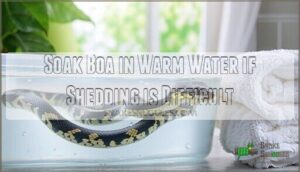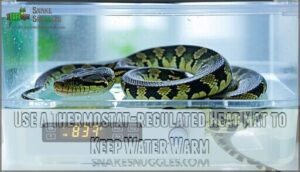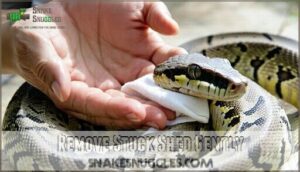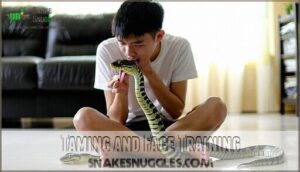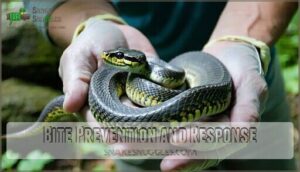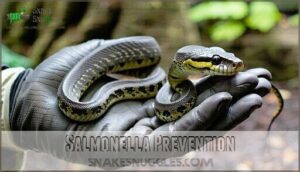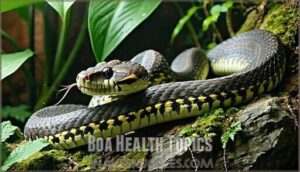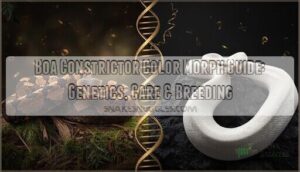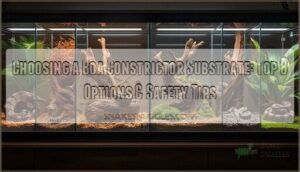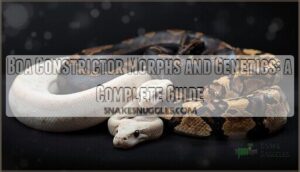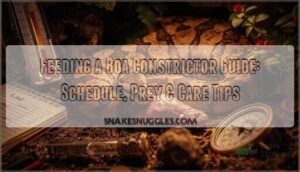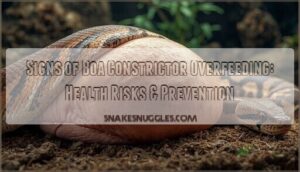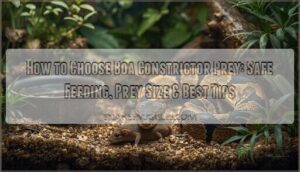This site is supported by our readers. We may earn a commission, at no cost to you, if you purchase through links.
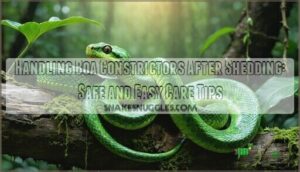
Your snake’s fresh skin is tender and sensitive, like a sunburn that needs time to heal.
During this recovery period, your boa might be grumpy or defensive since shedding is exhausting work.
Check that the shed came off completely, especially around the eyes and tail tip.
When you do handle them, use gentle movements and support their body weight properly.
Their vision returns to normal within a day, but their temperament might stay unpredictable for several days.
Understanding these post-shed changes helps you avoid bites and keeps your snake comfortable during this vulnerable time.
Table Of Contents
- Key Takeaways
- Shedding Process and Preparation
- Shedding Assistance
- Handling Boa Constrictors After Shedding
- Taming and Face Training
- Bite Prevention and Response
- Salmonella Prevention
- Boa Health Topics
- Frequently Asked Questions (FAQs)
- Do boa constrictors shed?
- How do you handle a boa constriction?
- How do you care for a boa constrictors snake?
- How can you tell if a boa constrictor is shedding?
- Are boa constrictors safe?
- How does a boa constrictor function?
- Can you handle your snake after it sheds?
- When should you not handle your snake?
- Are snakes vulnerable after shedding?
- Do snakes like to be touched when shedding?
- Conclusion
Key Takeaways
- Wait 48-72 hours before handling – Your boa’s fresh skin after shedding is tender and sensitive, like a sunburn, needing time to harden and heal properly.
- Check for complete shed removal – You’ll need to inspect your snake carefully, especially around the eyes and tail tip, to ensure no stuck pieces remain that could cause health problems.
- Handle gently when you resume – Use slow, gentle movements and support your boa’s entire body weight properly, since their temperament might remain unpredictable for several days after shedding.
- Expect defensive behavior during recovery – Your snake might be grumpy or more defensive than usual, since shedding is exhausting work, and their vision returns to normal within a day, but stress can linger longer.
Shedding Process and Preparation
Shedding is a natural and essential process for your boa constrictor’s growth and health.
By increasing the enclosure’s humidity to 80-90%, you can help facilitate smooth and complete shedding.
Normal Part of Life for Boas
Shedding is a natural part of your boa constrictor’s growth and health—it’s like upgrading to a new outfit.
Every few weeks, your snake outgrows its old skin. Shedding frequency depends on age, diet, and temperature.
Young snakes shed more often than adults because they grow faster. A poor diet or low temperatures can slow this process.
Keep an eye out for saggy skin as a sign shedding is near.
- Young vs. Adult: Younger snakes shed more due to rapid growth.
- Diet Influence: Poor diet may delay shedding cycles.
- Temperature Effects: Lower temps reduce growth rates.
Skin Becomes Opaque and Milky Blue-white Before Shedding
A boa constrictor’s shedding cycle begins when its skin turns opaque and milky blue-white, typically 7-10 days before shedding.
During this "blue phase," eye changes make the snake’s vision cloudy, increasing its vulnerability and defensive behavior.
Your boa’s cloudy blue eyes signal vulnerability—handle with extra care during this sensitive phase.
You might notice more tongue-flicking or head-shyness.
Verify proper humidity needs are met, as low moisture can cause stuck shed, while excessive humidity risks scale rot.
Monitor the snake’s pre-shed diet since many boas lose interest in eating during this defensive behavior phase.
Increase Humidity to 80-90% to Facilitate Shedding
When your boa’s skin turns milky blue, it’s time to boost humidity to 80-90%.
This supports the shedding process and prevents dehydration or shedding problems.
Use a hygrometer for accurate humidity monitoring and make simple enclosure adjustments like misting, adding a larger water bowl, or switching to a moisture-holding substrate.
Optimal humidity levels are essential for healthy shedding.
- Tip: A shallow water bowl raises humidity and also lets your boa soak if needed.
Shedding Assistance
If your boa struggles to shed completely, you’ll need to step in to help.
Soaking it in warm water and gently removing stuck skin can prevent health issues and guarantee its comfort.
Soak Boa in Warm Water if Shedding is Difficult
If stuck skin appears during the snake shedding process, a warm water soak can work wonders.
Fill a tub with lukewarm water, ensuring the water temperature stays comfortable. Let the boa constrictor soak for a couple of hours, softening the shed.
Use gentle removal techniques—never force it.
Persistent issues? Consult a vet to avoid harming your snake during the shedding phase.
Use a Thermostat-regulated Heat Mat to Keep Water Warm
Keeping a consistent temperature during a warm water soak is key to safe and effective boa constrictor care.
A thermostat-regulated heat mat guarantees the water stays warm without overheating, preventing burns. Place the mat under the soaking container and monitor the water temperature regularly.
Many reptile owners find temperature regulation products extremely helpful.
Follow these steps for ideal results:
- Set the thermostat to 85°F for a safe soaking environment.
- Position the mat securely under the container.
- Check water temperature every 30 minutes.
- Use a thermometer for precise readings.
- Adjust settings as needed to maintain comfort.
Remove Stuck Shed Gently
If you notice a stuck shed, focus on gentle removal to avoid harming your boa.
Use a damp cloth or your fingers to massage the area softly—never yank it off. A warm water soak can help loosen retained skin, including delicate areas like retained eyecaps.
Low humidity often causes stuck shed, so adjust enclosure conditions to prevent recurrence. Maintaining proper humidity, or preventing ball python stuck shed, is essential for healthy shedding.
Persistent shedding issues? Consult a reptile vet for professional snake shedding assistance and postshed handling tips.
Handling Boa Constrictors After Shedding
After shedding, your boa constrictor needs a bit of downtime before handling. Always wait at least 24 hours to let its new skin settle.
When you’re ready, focus on gentle handling to reduce stress and make for a smooth postshed period. Keep sessions short at first, gradually increasing as your snake adjusts. Support its entire body, allowing natural movement, and watch for signs of discomfort.
- Clean hands: Remove strong scents to avoid confusing your boa.
- Inspect the skin: Look for any retained pieces.
- Start slow: Limit initial handling time.
- Stay observant: Monitor stress signals closely.
Taming and Face Training
How do you build trust with your boa constrictor? Start with gentle, consistent handling sessions, keeping them short—just 5-10 minutes daily.
Focus on desensitization techniques like touch training, where you gently stroke the snake’s head to reduce shyness. Positive reinforcement, such as calm handling followed by feeding, encourages trust building over time.
For face training, allow your boa to explore near your face while staying relaxed and observant. Gradually increase handling duration as your snake becomes more comfortable.
Always respect its body language, and remember, patience is key when taming boa constrictors for safe, enjoyable interactions. To avoid defensive behavior, consider tapping the boa with a snake hook first.
Bite Prevention and Response
Bites from boa constrictors are uncommon and usually result from stress or mistaken feeding behavior.
Understanding their body language and staying calm if bitten helps guarantee both your safety and the snake’s well-being.
Bites Can Occur but Are Rarely a Serious Threat
Boa constrictors aren’t aggressive by nature, but defensive bites can happen during handling.
Bite severity remains minimal—their teeth cause shallow punctures, not deep wounds. Bite frequency drops substantially with proper snake handling techniques and regular interaction.
Understanding handling risks helps you stay confident around your boa.
Training impact shows remarkable results:
- Your confidence grows with each successful handling session
- Bond strengthens between you and your snake companion
- Fear dissolves as you master safe snake bites prevention
- Pride builds watching your boa’s trust develop over time
- Peace comes knowing you can handle any biting situation calmly
Do Not Panic or Punish The Snake if Bitten
Getting bitten happens sometimes, but don’t panic or yell at your snake.
Stay calm and gently remove the snake from your body.
Never hit or punish your boa – this creates fear and makes future snake bites more likely.
Understanding snake behavior helps with bite prevention.
Your snake isn’t being mean; it’s just confused or scared.
Responsible ownership means staying patient.
Adult boas need a 75+ gallon habitat to thrive.
Salmonella Prevention
You can prevent salmonella infection by washing your hands thoroughly with soap and warm water for at least 20 seconds after handling your boa constrictor or cleaning its enclosure.
Keep your snake’s habitat clean by removing waste promptly and disinfecting surfaces regularly, as reptiles naturally carry salmonella bacteria that can transfer to humans through contact, which is why it’s essential to maintain a clean environment to prevent the spread of infection.
Keep The Enclosure Clean
Clean snake enclosure maintenance prevents salmonella bacteria from thriving in your boa’s habitat.
Regular enclosure cleaning after shedding protects both you and your snake from harmful pathogens. You can maintain a healthy environment with specialized cleaning products.
Follow these snake hygiene essentials:
- Substrate Choice – Replace soiled bedding immediately after waste removal
- Water Bowl Hygiene – Disinfect weekly with reptile-safe solutions
- Cleaning Frequency – Deep clean snake shedding surfaces monthly for ideal snake enclosure health
Wash Hands Thoroughly After Handling
After handling your boa constrictor, proper hand hygiene becomes your first line of defense against salmonella and other zoonotic diseases. This pathogen removal process protects both you and your family from illness.
Scent elimination through thorough washing also prevents confusing your snake during future interactions.
To maintain cleanliness, consider buying quality soap.
Follow these essential steps for complete hygiene importance:
- Use warm water and antibacterial soap for effective pathogen removal
- Scrub vigorously for 20 seconds, focusing on fingernails and between fingers
- Apply hand sanitizers if soap isn’t available immediately
- Dry completely with clean towels to remove residual bacteria, ensuring complete hygiene and preventing the spread of zoonotic diseases with thorough washing.
Boa Health Topics
You’ll need to recognize common health problems that can affect your boa constrictor throughout its life, not just during shedding periods.
Understanding these conditions helps you provide proper care and know when to contact a reptile veterinarian for treatment.
Burns, Dehydration, and Inclusion Body Disease
After maintaining proper sanitation, you’ll need to watch for serious health conditions that can affect your boa constrictor.
Burns from faulty heating equipment show as red, blistered skin requiring immediate veterinary care. Dehydration appears through wrinkled skin and cracked eye caps—increase humidity to 80-90% and provide soaking opportunities. One key sign is sagging, wrinkled skin, indicating a lack of elasticity.
Your boa’s health depends on recognizing warning signs early—don’t wait until minor issues become major problems.
Inclusion Body Disease presents neurological symptoms like head tilting and abnormal shedding patterns. This fatal viral condition spreads between snakes, making quarantine protocols essential for disease transmission prevention.
| Condition | Key Warning Signs |
|---|---|
| Burns | Red, blistered skin patches |
| Dehydration | Wrinkled skin, difficulty shedding |
| IBD | Head tilting, regurgitation, weight loss |
Mites, Mouth Rot, and Respiratory Infection
These three health issues can turn your boa’s world upside down if left unchecked.
Mites spread dangerous diseases like Inclusion Body Disease, while mouth rot causes painful gum inflammation and tooth loss.
Respiratory infections often signal poor husbandry practices that compromise your snake’s immune system.
- Watch for excessive rubbing against surfaces – classic mite prevention warning signs
- Check gums regularly for redness or swelling indicating mouth rot development
- Monitor breathing patterns for wheezing or open-mouth respiratory signs
- Seek immediate veterinary care when infection treatment becomes necessary
- Maintain proper humidity and cleanliness for ideal boa health protection
Frequently Asked Questions (FAQs)
Do boa constrictors shed?
Like clockwork, your boa constrictor sheds its skin multiple times yearly as it grows.
Young boas shed every 4-8 weeks, while adults shed four to five times annually, replacing old skin with fresh, vibrant scales.
How do you handle a boa constriction?
Support your boa’s entire body with both hands, moving slowly and confidently.
Never grab the tail or restrict movement.
Let it coil around your arms naturally while maintaining a gentle, secure grip throughout.
How do you care for a boa constrictors snake?
Coincidentally, caring for your boa constrictor mirrors tending a houseplant—you’ll need proper temperature (78-88°F), humidity (50-60%), spacious enclosure, weekly feeding, fresh water, and regular health checks for ideal snake wellness.
How can you tell if a boa constrictor is shedding?
You’ll notice your boa’s eyes turn cloudy blue-white, skin becomes opaque, and they hide more often.
They’ll stop eating and appear darker overall.
This "blue phase" happens 7-10 days before they actually shed.
Are boa constrictors safe?
Boa constrictors are generally safe when you handle them properly.
They’re non-venomous and rarely aggressive toward humans.
You’ll face minimal risk if you support their body, move slowly, and respect their space during feeding or shedding periods.
How does a boa constrictor function?
Picture a massive python wrapping around a deer – that’s your boa’s hunting method in action.
Your snake kills by constriction, squeezing prey until circulation stops, then swallows whole using flexible jaws.
Can you handle your snake after it sheds?
Wait 24-48 hours after your snake sheds before handling.
The new skin is delicate and needs time to harden.
Handle gently when you resume, supporting the body properly to avoid damaging fresh scales.
When should you not handle your snake?
Avoid handling your snake during feeding time, within 48 hours after eating, when it’s "in blue" before shedding, during active shedding, or when it’s showing signs of illness or stress.
Are snakes vulnerable after shedding?
Just like fresh sunburn makes your skin tender, your snake’s brand-new scales are delicate after shedding.
You’ll need to wait 24-48 hours before handling, as their soft skin needs time to harden and adjust.
Do snakes like to be touched when shedding?
No, snakes don’t enjoy being touched while shedding.
You’ll stress them out during this vulnerable time. Their cloudy eyes impair vision, making them defensive.
Wait until they’ve completely shed before resuming gentle handling sessions, as this allows them to recover and become less defensive.
Conclusion
Many handlers worry they’ll harm their snake by waiting, but patience protects both you and your boa.
Handling boa constrictors after shedding requires restraint and understanding. Your snake’s skin needs time to toughen up after emerging from its old layer.
The 48-72 hour waiting period isn’t arbitrary—it’s based on how long fresh skin takes to recover. Watch for complete shed removal, especially around eyes and tail.
Gentle movements and proper support make all the difference when you resume handling, ensuring a safe and healthy interaction with your boa.
- https://reptifiles.com/boa-constrictor-care/sick-boa/shedding
- https://www.boa-constrictors.com/en/Interesting_facts_about_Boa_constrictor/Boa_constrictor_Care/Shedding
- https://fancyfeather.com/blogs/fancy-blog/how-to-keep-a-feather-boa-from-shedding
- https://www.reptifiles.com/snake-bite-strike-constricting/
- https://www.quora.com/After-the-snake-sheds-will-it-still-be-near-the-place-it-did

